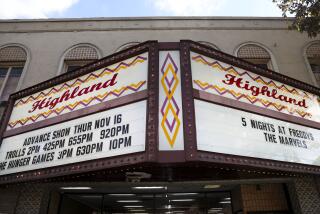Will the Alamo Drafthouse L.A. be the last stand for movie theaters?
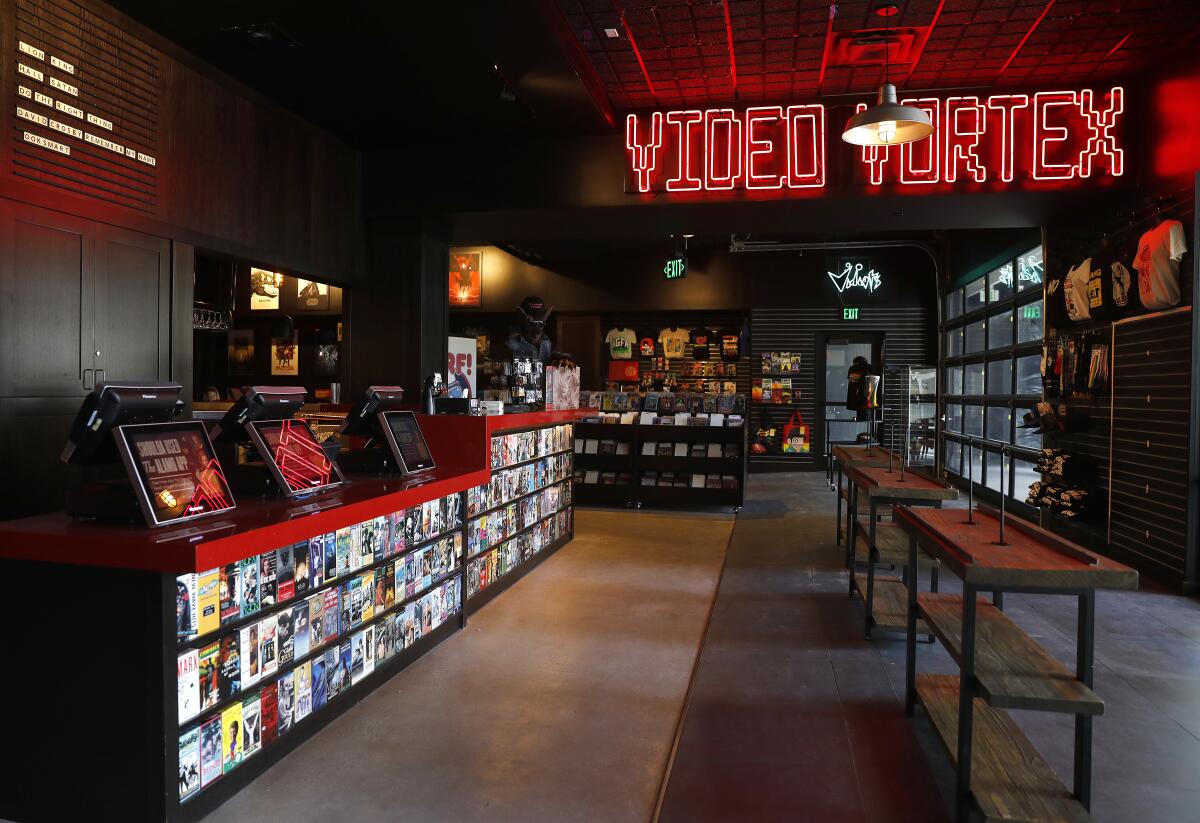
Tucked into an upper corner of the open-air plaza of the Bloc in downtown Los Angeles, the Alamo Drafthouse chain of movie theaters is opening its first location in Southern California this week. From this unlikely perch, the venue has its sights set on nothing less than becoming a new and vital home for film-goers in Los Angeles and a focal point for a fervent community of movie fans.
Yet the timing — coinciding with a series of industry headlines and conversations about a perceived box office slump, somewhat masked by a handful of outsized franchise blockbusters — feels particularly risky for an ambitious new theatrical venue.
The simultaneous onslaught of content from streaming services such as Netflix, Amazon and Hulu — with more on the way — has led many to wonder if the theatrical experience itself is endangered, at best becoming an increasingly rarefied experience like opera or at worst disappearing completely like an old-time telegraph office.
“I don’t know if people don’t want to go to theaters anymore. I think people want the experience to be worthwhile,” said Anam Syed, head of marketing for the Alamo Drafthouse L.A. “Are they being served the things that they want, basically. Are you having fun?”
The long-awaited venue has a sneak peek beginning Friday, open at first for members of the Alamo Victory club and then to the general public on Saturday. During the sneak peek period, tickets are full price but there will be select discounts on food and beverages as the staff continues to iron out service. An official grand opening will follow sometime in August.
Regal L.A. Live is introducing a French movie theater technology that enhances the onscreen action with five LED side panels in the auditorium.
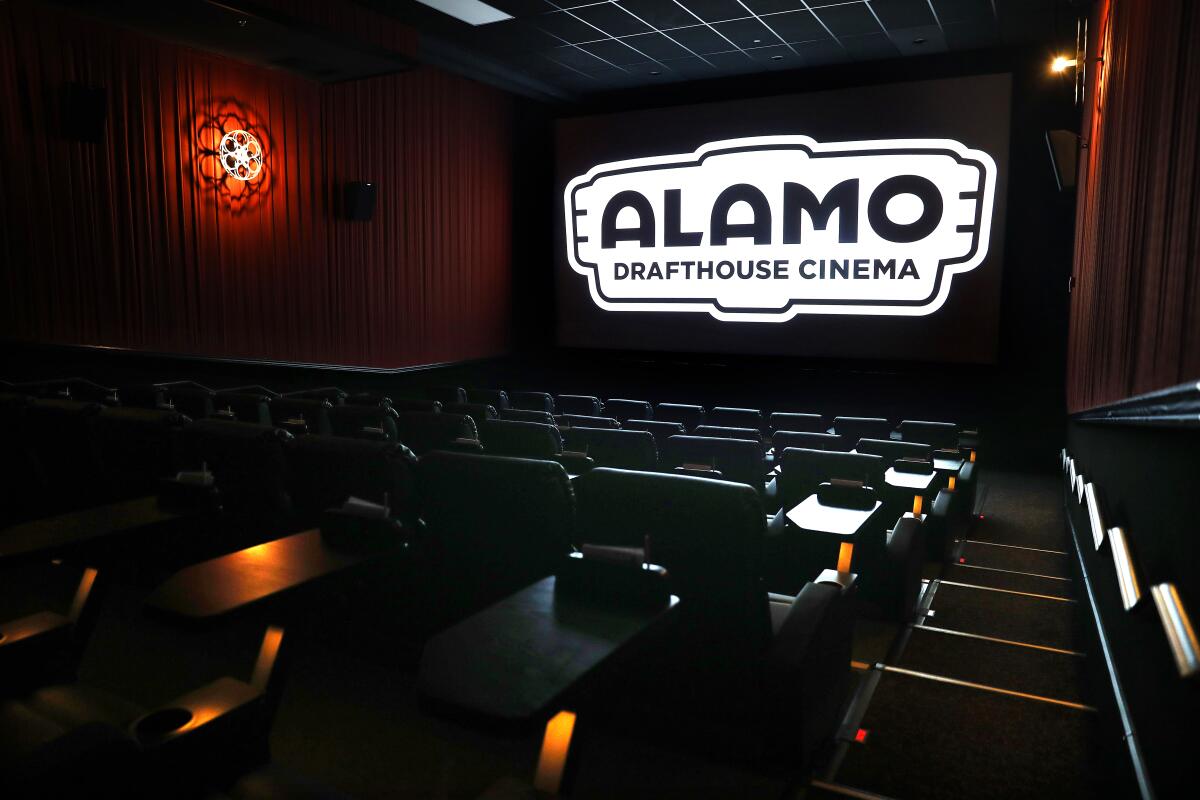
The Austin, Texas-based Alamo Drafthouse chain, which was founded in 1997, places a particular emphasis on a friendly, fun-loving atmosphere with a splash of the out-there and outré. The Alamo Drafthouse L.A. houses 12 theaters ranging from 40 to 63 seats for a total of 569 seats and an average ticket price around $17-$18.
The venue’s lobby and lounge area also includes Video Vortex, a video store offering free rentals and an inventory of some 40,000 titles drawn from a closed Austin store. An initiative for table-top gaming has been announced, with games available to play for free along with tournaments and events.
The chain was among the pioneers of in-seat service, with an extensive menu of food and beverages available to be ordered and served in the theater. Alamo Drafthouse also prides itself on a strict policy of no texting or talking during a movie, once notoriously transforming the angry voicemail from an ejected patron into an ad to warn other customers to stay quiet and put down their devices.
But the question remains. At a moment where many feel that the theatrical business is in peril and that streaming services are becoming the dominant force in entertainment, why would a theater want to launch into Los Angeles in such a big way?

“I feel like that’s the wrong competitor in the fight. I’ve never felt we’re at war with any streaming services,” said Tim League, founder and CEO of Alamo Drafthouse Cinema. “No matter what, everybody wants to get out of the house. So we’ve always considered ourselves to be in competition with restaurants, with roller skating, with going to see live music. The idea is to offer an experience based around movies that competes from a value proposition with all the other things that are in the out-of-home entertainment arena.
“I love what’s happening with streaming,” League added. “And I’m comfortable with the idea that cinema is alive and well and will continue to be alive and well provided that everybody in this industry focuses on making a great experience.”
The L.A. theater will open with a mix of studio titles such as “Spider-Man: Far From Home” and “The Lion King,” with Quentin Tarantino’s latest, “Once Upon a Time … in Hollywood” arriving on July 26. They will share screens with releases from smaller companies such as “Midsommar,” “Book Smart” and “The Art of Self-Defense.” Also playing will be the new 4K restoration of “Do the Right Thing.”
Local venues such as the ArcLight Hollywood and the Landmark already frequently work that same mix of studio and arthouse fare. But they do it without the additional sustained emphasis on repertory programming and special events presented with the showpeople’s panache that is the hallmark of the Alamo Drafthouse brand.
“There’s a lot of stuff going on in Los Angeles, a lot of variety, but most of it is always pretty segregated,” said Syed. “You can go to a Q&A with the celebrity on the Westside. You can see the tiny art film in some little pop-up space on the Eastside. And Drafthouse is the only place where it’s under one roof. We’ll have a family coming in for ‘The Lego Movie’ in the morning and then some nerds coming for a reptile movie from the ’60s and then everything in between.”
“A big thing for us is that it is for everyone,” said Rachel Walker, head of programming and creative at Alamo Drafthouse LA. “We want to appeal to all film fans as much as possible.”
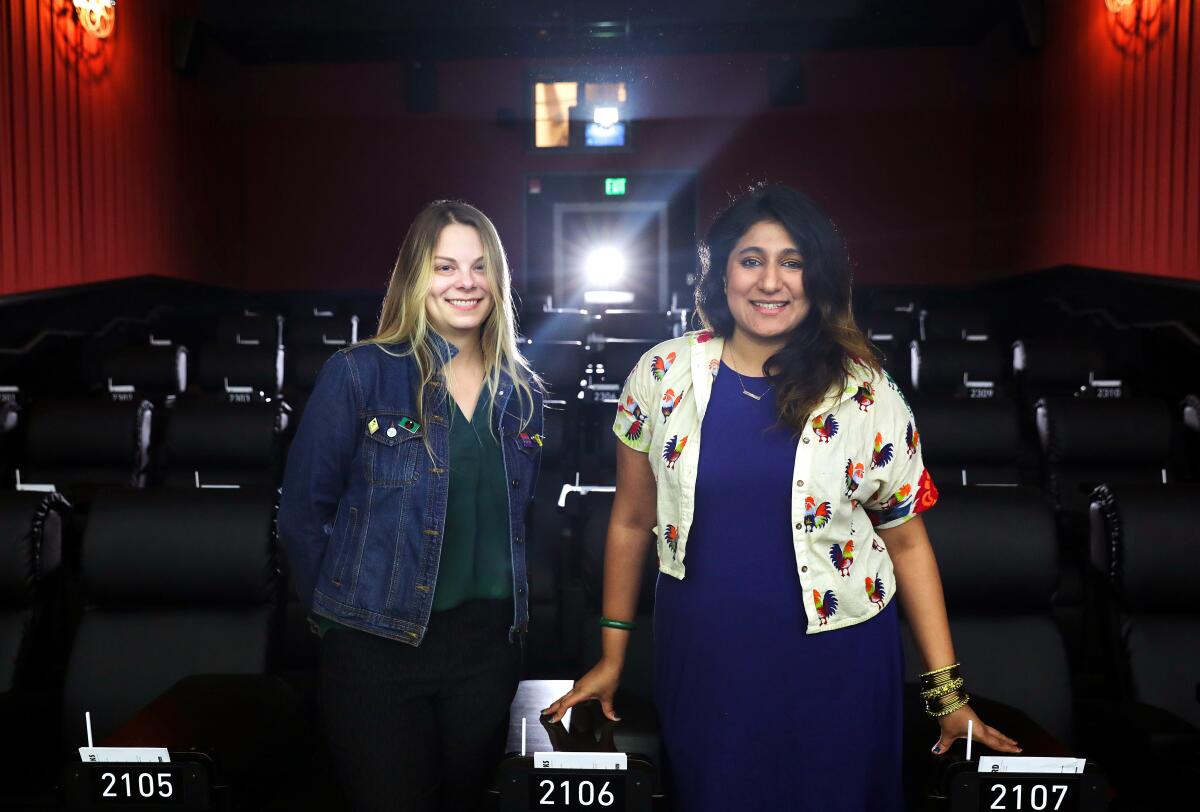
In August the theater will launch its more esoteric specialized programming, beginning with a screening of Buster Keaton’s 1928 silent comedy “Steamboat Bill, Jr.” The regular Terror Tuesday program will launch with the L.A. premiere of the 4K restoration of 1986 horror comedy “Chopping Mall.” Also on the Terror Tuesday lineup for August: “Night of the Comet,” “Black Christmas” and “Tenement.”
The ongoing Weird Wednesday series also will debut in August with the outrageous adventure story “Roar.” Additional August highlights include a program of Stephen King adaptations featuring “It: Chapter One” (the sequel lands on Sept. 6) and a series dedicated to stunts, including “Hooper” and “Drunken Master.” Danish filmmaker Mads Brügger’s new documentary “Cold Case Hammarskjöld” will make its theatrical bow alongside screenings of his previous films “The Red Chapel” and “The Ambassador.” There will be a participatory movie party screening of “Mad Max: Fury Road” and a quote-along screening of “Labyrinth.”
Adding to the eclectic mix, Kids Camp screenings of “Paddington 2” and “The Iron Giant” will target families and allow for flexible $1, $3 and $5 ticket prices. The Care Package series spotlighting documentaries opens with “Skid Row Marathon,” set amidst downtown Los Angeles. And the Drafthouse will host a live recording of the popular podcast “Unspooled,” featuring Paul Scheer and Amy Nicholson.
“Aside from making everything an experience and a reason to get out of your house and go see something, I do think everything really does fit this Alamo brand,” said Walker. “Obviously there’s so many things on streaming and you can just plop something on. But having something as highly curated as everything is at the Drafthouse creates a sense of urgency for whatever that title is. Maybe you’ve always meant to see something — the time to see it is now, playing on the big screen. And so it’s curated discovery.”
Beyond the larger existential crisis of the movie industry, the Alamo Drafthouse also enters a local moviegoing community bustling with activity, but one that remains stubbornly diffuse and, in the stereotypical manner of Los Angeles, decentered.
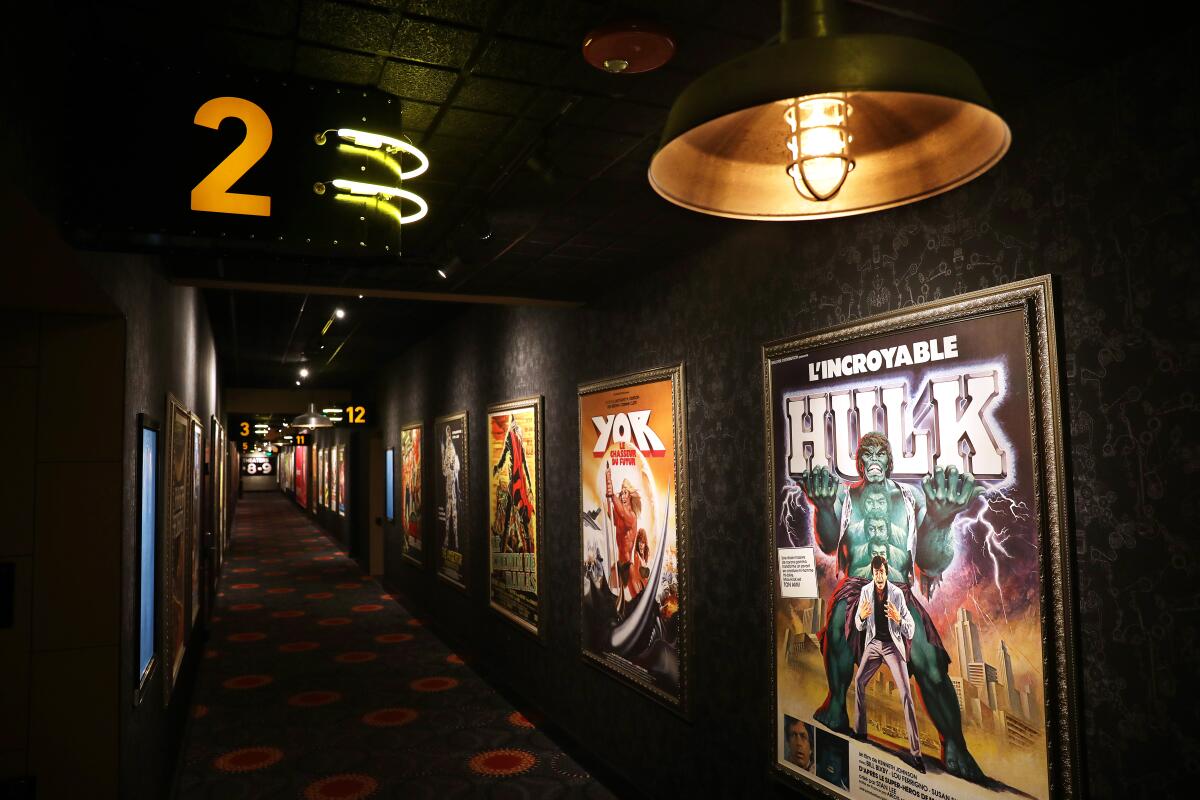
The 50-seat Amanda Theater, part of filmmaker Ava DuVernay’s ARRAY creative campus in Echo Park, plans to announce its inaugural six-week fall program in late August. Negotiations are ongoing for Netflix to purchase the Egyptian Theatre in Hollywood from the American Cinematheque, which also runs the Aero Theatre in Santa Monica. The UCLA Film and Television Archive features a smart mix of programs in Westwood. The New Beverly Cinema in the Fairfax district, owned and programmed by Quentin Tarantino, is unpredictable and idiosyncratic.
The citywide Laemmle chain of theaters, specializing in arthouse titles, routinely features movies that otherwise would not find a place to play in L.A. Pop-up programs such as Acropolis Cinema and Projections bring rare titles to local screens. The Now Instant Image Hall in Highland Park and the Underground Museum in Arlington Heights are among the other venues around the city providing alternative screening spaces.
In 2017 the Cinefamily, known for esoteric programming and a freewheeling attitude, collapsed following revelations of harassment, abuse and mismanagement from senior staff. While its dedicated audience has dispersed to other venues, there has nevertheless remained a feeling that the venue’s role within the larger fabric of the Los Angeles film scene has never quite been replaced.
“The one thing Cinefamily had was a hub position. It was sad to see that go, a place where you were sure to run into and mingle with other cinephiles on a regular basis,” said L.A.-based film writer April Wolfe, who is scheduled to appear at the Alamo Drafthouse L.A. in August to introduce the original “Black Christmas,” for which she co-wrote an upcoming remake.
“There is the potential for Drafthouse to fill that spot, depending on what kind of theater it wants to be,” Wolfe added. “Do they want to be just a first-run theater for the masses or a combination of that and a hub for local weirdos?”
Alamo Drafthouse has itself not been immune from controversy. After critic Devin Faraci was let go from the Drafthouse’s in-house publication Birth.Movies.Death in 2016 following accusations of sexual abuse and harassment, League quietly hired him back in another role until online outcry in 2017 caused Faraci to leave permanently. Then it was also revealed in 2017 that League had downplayed incidents of harassment at theaters in Austin, most specifically involving website publisher and critic Harry Knowles.
In moving from one single-screen theater in Austin to opening 40 venues around the country and having some 6,000 employees, League acknowledges that he often overemphasized the customer experience without considering the internal corporate culture he was fostering. And that he often moved too quickly from decision to decision.
The company has instituted a clear code of conduct, started a staff advisory council and hired a chief people officer.
“It was an opportunity for pretty heavy self-reflection and growth as a company and maturity as a company,” League said. “So standing here today, I’m really proud of the company and the culture that we have.
The idea of structuring the company to have individual, unique and diverse voices in every market, that reflect the tastes of that market is certainly willful.
— Tim League, founder and CEO of Alamo Drafthouse Cinema
“The early days of Alamo, the theater was a reflection of me, and I am who I am,” League said on how the company has moved forward. “But the idea of structuring the company to have individual, unique and diverse voices in every market, that reflect the tastes of that market is certainly willful. And we continue to do that across the country as we grow. I personally will never lose my love of weirdo genre movies, but we support a lot more than that.”
Syed and Walker, who did not work for the Alamo Drafthouse when it was undergoing those internal cultural shifts, demur from commenting on specific incidents in the company’s past. But they are well aware of its fallout and the fact there may be people who have reservations about supporting the company.
“There’s definitely online chatter that we’re aware of,” said Syed. “I manage our social media feeds and I see it on Twitter every day.
“But I firmly believe there are two ways that you can truly diversify anything: It’s write a check or pass the mic. And Tim League has done both, in our case,” Syed said. “He’s really done the work. Drafthouse has done the work. We have a very strict and tip-top code of conduct. Zero tolerance policy in our staff. We truly do have leadership positions as voices here to craft our theater.”
The nearest theaters to the Alamo Drafthouse location within the complex of the Bloc downtown are the Regal Cinemas multiplex at L.A. Live and the single-screen Downtown Independent.
“I don’t think I would ever use the word ‘competitor,’” said League of describing his view of other theaters in the city. “Because I’m very much an ‘all ships rise’ kind of a mentality when it comes to cinema. I mean, we’re all trying to do the same thing and find an audience. I don’t think we’re going to impact the Regal L.A. Live, which is the closest to us. I want all theaters to succeed. And we generally come into a new city with a very open attitude and collaborative attitude.
“We’re a neighborhood theater,” League said. “L.A.’s just so big. There’s so much population that certain neighborhoods I think are under-screened. So I’m not going to initiate an antagonistic relationship with L.A. Live or any of the independent theaters. And if there’s a means by which we can help support their efforts and programming, we’ll do so.”
That collaborative feeling was shared by James Kirst, founder and executive director of the Downtown Independent, when he said, “I really hope most that with Drafthouse in downtown, we can work together to create a more robust destination for cinema and moviegoing. Whether that happens from a direct relationship with them or organically, at the end of the day moviegoers are going to be the biggest beneficiaries of the expansion of cinema in Los Angeles.”
It will be worth watching to see how Drafthouse finds its own equilibrium, balancing out big-budget studio films with smaller independent releases that may require more patience and care. Even at a venue that prides itself on its eclectic sensibilities, there can be a concern that tentpoles will dominate the screens and keep other films from building word-of-mouth and finding their potential audiences.
“That’s a concern within the industry at large. I know a lot of studio friends that when they have smaller titles are like, ‘What do we do?’” said Syed. “But I think that’s what Drafthouse does really well. We kill it in the game in terms of the sort of mid to smaller releases — obviously A24 titles do excellent with us, or Annapurna titles do excellent with us. We really are the home for all of those films that the industry is scared of. [If someone asks], ‘What will we do with this movie,’ they have a home at Drafthouse.”
The essential challenge for the incoming Alamo Drafthouse L.A. may be how much it blends into the fabric of venues already operating around Los Angeles and how much it creates an audience all its own. Does a city synonymous with the movie industry even need a central hub for local moviegoing, movie-loving audiences?
“We find everywhere we go, whether it’s small town or big town, there’s always a community of people that are aligned with our sensibilities, that love movies, love what we stand for,” said League. “So for sure we’re tapping into that audience that definitely exists in Los Angeles, but then we also want to build our own.”
“The moviegoing community in Los Angeles is far more diverse than a lot of Angelenos realize, because people tend to get caught up in their bubbles,” said Wolfe. “But there’s stuff happening everywhere, in South L.A., all over the Valley. The problem will always be that with such a sprawl, we tend to get insular, and that’s not good for a sustainable film community. I know we’re all talking about the death of the theatrical experience, but in L.A., it seems pretty alive to me.”
SIGN UP for the free Indie Focus movies newsletter »
Follow on Twitter: @IndieFocus
More to Read
Only good movies
Get the Indie Focus newsletter, Mark Olsen's weekly guide to the world of cinema.
You may occasionally receive promotional content from the Los Angeles Times.
